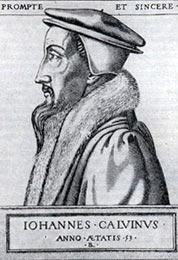Calvinism

 Calvinism began spreading in Ukraine at the beginning of the 1540s and is associated with the activities of prominent cultural figures, writers, scholars, and politicians who were interested in Protestant ideas. The first advocates of religious reform were the most educated people, who were invited by wealthy people to teach their children and expand the research and educational process in the country. Out of the first preachers – who worked in Ukraine as cultural figures, translators, and writers – information remains about Foma Falkovskyi, Pavlo Zenovych, Mykola Zhytnyi, and Oleksandr Vitrelin. In Ukraine, Calvinism spread throughout the territory of Volhynia and Galicia to Podillia and the Kyiv region, but the conventions as well as schools and printing houses were concentrated mainly in western Ukraine. The first synod was held in 1554 and it united the Calvinist community of the Polish Commonwealth. In 1562 in the Princes Radziwills’ Nesvizh printing house the first Ruthenian-language Calvinist Catechism was printed, which was prepared by Shimon Budnyi.
Calvinism began spreading in Ukraine at the beginning of the 1540s and is associated with the activities of prominent cultural figures, writers, scholars, and politicians who were interested in Protestant ideas. The first advocates of religious reform were the most educated people, who were invited by wealthy people to teach their children and expand the research and educational process in the country. Out of the first preachers – who worked in Ukraine as cultural figures, translators, and writers – information remains about Foma Falkovskyi, Pavlo Zenovych, Mykola Zhytnyi, and Oleksandr Vitrelin. In Ukraine, Calvinism spread throughout the territory of Volhynia and Galicia to Podillia and the Kyiv region, but the conventions as well as schools and printing houses were concentrated mainly in western Ukraine. The first synod was held in 1554 and it united the Calvinist community of the Polish Commonwealth. In 1562 in the Princes Radziwills’ Nesvizh printing house the first Ruthenian-language Calvinist Catechism was printed, which was prepared by Shimon Budnyi.
In the 1560s there were close to 300 Reformed communities.
The evolution of Calvinism in Ukraine can be divided into three stages: the origin of the denomination in the 1540-50s; the golden age in the 1560-80s; and the end of the sixteenth to early seventeenth centuries, which saw the gradual decline of the communities’ activity. In the 1650-60s most of their activity stops.
In 1565 from the Calvinist Church evolves the so-called Minor Church, which is called Polish Brethren by its members. Opponents called them Arians or Antitrinitarians because of their rejection of the dogma of the Holy Trinity.
It should be noted that the spread of Calvinism in Ukraine is closely connected with its spread in Poland and Belarus because it belonged to the Polish Commonwealth. The Calvinists’ influence in the Polish Sejm was significant because they belonging to Calvinist high nobility. Overall, due to the efforts of Prince Nicholas Radziwill the Black (1546-1589), who was chancellor of the Grand Duchy of Lithuania, Calvinism was dominant for some time among the magnates and gentry of the principality, which at the time covered a significant portion of Ukrainian lands.
By the middle of seventeenth century there are good relations between Calvinists and the Orthodox. The most important consequence of their understanding was the act of the Warsaw Confederation of 1573, which guaranteed on the territory of the Polish Commonwealth equality of Christian denominations and prohibited the use of weapons to resolve interdenominational conflicts. This article is also included in the Pacta Conventa – the oath taken by each newly elected king of the commonwealth. During the dangerous period from the side of Catholicism, the communion of the Orthodox and Calvinists was even welcomed by the Ukrainian Cossacks. There was even talk about concluding a union between them to replace the union with the Catholic Church. However, the success of Calvinism proved to be short-lived. Calvinists were unable to unite into a powerful religious alliance, to get the sympathy of the people or the support of Orthodox nobles and clergy. Later, as the movements continued to evolve the theological irreconcilability between the Orthodox and Calvinists became apparent.
The second half of the seventeenth century to the beginning of the eighteenth century was the period of the greatest decline of Protestantism in Ukraine, which had become a hot spot for hostilities. Russia, Poland, Sweden, and Turkey fought for the division of its territory, and, on the other hand, Ukrainian Cossacks, peasants, nobles and commoners fought for its independence. Over time, Protestants were deprived of the support of the nobles and their number significantly decreased. Eventually most of Ukraine’s territory was annexed by the Russian Empire and the western lands went to Austria. Religious freedom in the Russian Empire was greatly limited. In the first half of the eighteenth century isolated Lutheran and Calvinist (Reformed) communities still operated in Ukraine.
In the second half of the eighteenth century by the decision of Catherine II colonization begins of conquered territories in southern and eastern Ukraine. The most significant part of the colonists was German and Dutch Mennonites, who as experienced workers were invited to develop new territories. They formed colonies with fellow believers and lived quite separately from the Ukrainian population, although they employed Ukrainians. Historically, Mennonite (named after its founder Menno Simons) is a branch of extreme Calvinism and early on was following the tenets of predestination and total depravity. Mennonites profess the principle of the Scripture Alone, the principle of universal priesthood. However, unlike the Calvinists, they confess and practice baptism only for adults through total immersion or affusion. In the second half of the 1870s and in the 1920-30s, a large part of the Mennonite community in Ukraine immigrated to the USA, Canada, and South America. In the 1960s another part of the community joined the Union of Evangelical Christians-Baptists of the USSR.
Close to the Calvinist doctrine was the doctrine of the Russian Union of Baptists for the salvation of man, written in the early twentieth century. At the beginning of 1990s, however, the majority of Evangelical Christians-Baptists were already closer to the Arminianism doctrine of salvation. With the advent of religious freedom much of the local believers had the opportunity to study abroad, particularly in schools that professed Calvinist doctrine. Consequently, the number of Ukrainian Baptists who professed the Calvinist view of salvation increased; although on the official level Arminian views on the salvation of man prevail.
With the opening of borders overseas missionaries were able to open new churches. Through the missionary work of Fylymon Semenyuk in Rivne and Stepan in 1992 Reformed Church were registered, and in 1996 the Evangelical Presbyterian Church was registered in Odesa.
According to statistics from January 1, 2008, Ukraine had 65 registered Presbyterian communities. The vast majority of them are located in southern and central Ukraine. There are two schools, 27 Sunday schools, one periodical, and 76 priests. The Presbyterian Church of Ukraine is supported by their coreligionists in the USA and South Korea.
The churches profess Calvinist doctrine and use the Westminster Confession of Faith, drawn up and adopted in 1649 at the Westminster Assembly in England. There are sacraments: water baptism and Holy Communion. Baptisms are performed for both adults and children of believing parents. Immersion during baptism is not necessary; aspersion of affusion is also accepted. Worship occurs in modest settings. It is accompanied by the singing of professional choirs. Preaching of the Gospel is done from the pulpit in the native language; general singing is from the book of Psalms. Churches follow the collegiate guide of communities.
Presbyterian Churches in Ukraine have 10 prayer rooms, 43 more rooms are rented for worship.
Besides spiritual work, Presbyterian Churches are actively involved in charitable work (soup kitchens, rehabilitation centers, providing equipment, medicine, furniture, and baby food to children’s medical clinics).
The churches of the Evangelical Presbyterian Church of Ukraine (EPCU) are also included in the Union of Evangelical Reformed Churches of Ukraine. The Union of Evangelical Reformed Churches is composed of Presbyterian and Reformed Churches of Ukraine. The union includes about 20 churches.
The Evangelical Reformed Seminary of Ukraine is a joint institution of the Ukrainian Evangelical Reformed Church and the Evangelical Presbyterian Church of Ukraine. Now the seminary has about 50 students.
Another church of Ukraine that adheres to Calvinist theology is the Sub-Carpathian Reformed Church (SCRC), which historically came from the Hungarian Reformers. The majority of the church’s faithful are ethnic Hungarians. In Hungary, Protestantism originally spread in the form of Lutheranism, but around 1557 most of the Hungarian Calvinist Protestants adopted the Confession of Czenger.
In Transcarpathia the first communities of Reformers appeared in the 1520-30s. Today the SCRC consists of 114 communities, which are served by 53 clerics. The SCRC is part of the World Communion of Reformed Churches; it is guided by the communion’s precepts in organizational matters, but maintains autonomy in management. The church operates in 8 districts of the Transcarpathian region. This area is divided into three church districts (Uzhanskyi, Berezskyi, Maromarosh-Ugochanskyi), which are subordinate to the governing board of the SCRC. The highest power is exercised by the General Assembly and the Synod of the Governing Board of the SCRC. The bishop of the church and synod serves for four years. The community has 107 Sunday schools. The church finances three boarding schools, where, in addition to compulsory general subjects, religious and theological subjects are taught. The SCRC does not have its own spiritual institution so seminarians study abroad.
In the village Velyka Dobron of Uzhhorod district a charity boarding hourse for mentally challenged children was founded, which is run by the specialized SCRF Charitable Foundation. Since 1998 the church publishes a quarterly called Küldetés (Mission) – an organ of the governing board of the SCRC.









